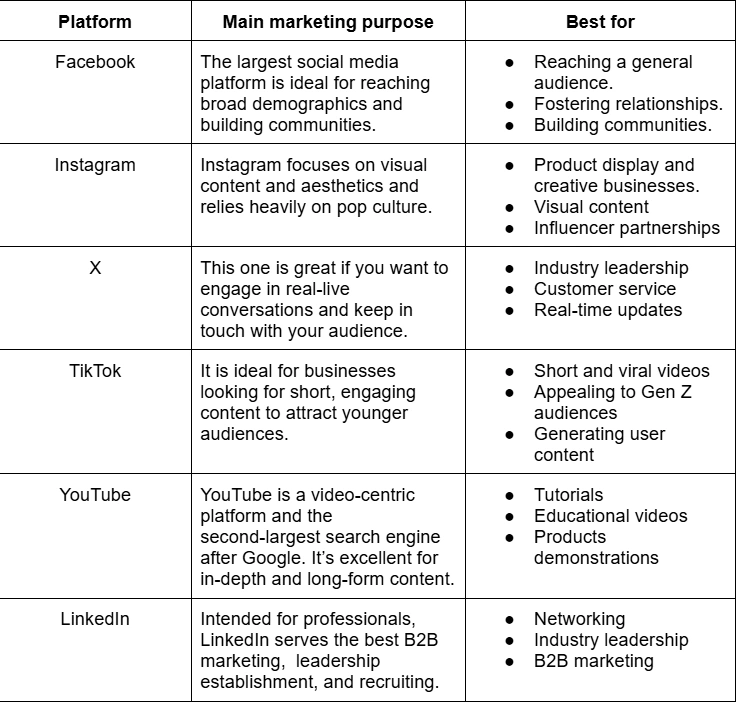Nowadays, it’s the norm that almost everyone has at least one social media profile, even if it’s a Facebook profile they haven’t touched in three years. Social media presence is one of the critical factors that determine whether or not customers do business with a company. If they come across your business’s name, they will pull it up on Instagram or Facebook to see what’s up with you.
Thus, if you want to grow your business from small to medium, social media can be a great ally in increasing your business reach, fostering customer loyalty, and generating more sales over time. However, this won’t happen overnight, and before rushing to Instagram to post pictures of your products like crazy, you will need to craft your social media marketing strategy to ensure every post is a step in the right direction to grow your business.
But don’t get nervous. Though it can seem like a lot of work, if you read until the end of this post, you’ll discover that crafting a master plan for your business social media is just a matter of organization and analysis. Dive into these 5 tips to create a social media strategy, even if you’re just beginning!

When we talk about social media marketing, we mean using social media to promote your business and connect with your audience.
Most businesses’ primary social media goals are to showcase their products and services and personally engage with their customers. Generating customer engagement is the most important of these two.
Social media platforms are intended to foster user relationships and promote community growth. Thus, more than endless promotional posts about your products and services, users will enjoy valuable posts and active customer service that shows you care about them.
These unique characteristics of social media make it a marketing tool like no other. It allows you to promote and grow your business while fostering loyalty and recognition between your new and existing customers for free.
Now, if you’re wondering how to do all this when you’re just starting, don’t stress too much. With these five tips, you can make your social media marketing strategy from start to finish like you have your own social media marketing consultant working with you.
If you’ve been in the marketing game for a while, you may notice that setting goals for your marketing strategy is one standard tip that almost everyone shares. We do it because it is crucial, and we’re not exaggerating. You waste time, money, and effort if you start posting without clear social media goals, whether your strategy is organic or paid advertising.
You may get a hundred likes on your TikTok video, but it is time to review your strategy if your sales are still stuck mid-quarter. Now, we’re not against using trends and making jokes occasionally, but set a goal for your social media strategy before jumping into the latest trend.
Remember to make your goals and objectives using the SMART technique so they are reachable for you, not just pretty words to put on a report. Each of your social media goals should be:
And they should be aligned with your business’s primary goals. If, for example, your business aims to be the most known general building contractor in Jensen Beach, then one of your social media goals could be to increase your brand awareness. To make it SMART, we could complement it like this: increase brand awareness by 8% in the first quarter of 2025.
Knowing whose people you want your post to reach on social media platforms is essential in increasing your chances of success. If your post doesn’t get an audience interested in your products or services or if they don’t see how your business can improve their lives, your results will be disappointing, and you may think all your efforts are in vain.
You can use several social media tools to research your ideal audience. From third-party tools that let you plan and schedule your content to the audience features inside most social media platforms like Facebook or TikTok. Look for the available data on the following aspects to create your targeted audience:
Also, remember that your ideal audience can vary depending on the platform, so it’s important to define different audiences for each social media platform you will use in your social media strategy.
Choose which social media channels to invest your marketing resources based on your industry and target audiences.
For example, if you offer cognitive rehabilitation for seniors, you may want to start posting on Facebook or Instagram. The main age groups on these social media platforms are 25- 34, meaning you can easily reach people interested in your therapies for their parents. Also, compared to others like TikTok, you can get to older age groups on these platforms.
If you feel you could use a little help choosing your social media channels, we have a breakdown of each of the most significant platforms for you to see which purposes they serve best:

While it may be tempting to open a profile on every social platform ever created to “broaden your reach,” remember that creating content for five different platforms requires a lot of resources and effort, and it can be exhausting to maintain that rhythm in the long term. The key to developing a great social media strategy for small businesses is to invest your resources into the social media with the highest potential for return on investment.
Analyzing your competitors’ social media activity is a great way to understand what is common practice within your industry, what people expect from businesses, and what is working or not for your competitors. It also lets you spot some strengths and weaknesses that you can address in your social media marketing strategy.
For instance, if the main competitor for your contractor firm focuses on Instagram and posts reels every day but posts on Facebook once every blue moon, you can take advantage of this empty spot to attract an underserved audience on this platform.
Although the primary goal of a competitive analysis is not to copy your rivals, you can draw inspiration from them. A good social media marketing strategy will be leveraged by tackling topics and social media trends that spark the interest of your audience. Say, if you’ve seen your competitors start a conversation about the latest building management program, find a new approach to it to post on your social media.
To start analyzing your competition’s social media, you can opt to look up their names on the platforms you plan to use or use any social listening tool to monitor accounts, relevant keywords, and hashtags. If you already use a social media planning tool, they may have this feature included.
Analyzing your performance metrics is vital to ensuring your social media strategy works.
If your designer spent one and a half hours creating an Instagram carousel to promote your services, you can’t just post it into the world with hopes for the best without defining how you will measure its success. What if it gets only three likes, and you get disappointed but overlook that it increased customer-initiated conversations by 3%?
So, while defining your social media goals and creating your content schedule, take the time to set the key metrics you’ll need to focus on to determine whether your social media plan is producing results. Hence, let’s bring back our initial example, the one about the general building contractor aiming to be the best-known one in Jensen Beach. We aimed to increase brand awareness by 3% in the first quarter of 2025.
In this case, some of the metrics we could focus on are:
After defining your metrics, the next step is to analyze them within a period of your choice. Depending on the type of content you publish and how often you post, this period can be weekly, daily, monthly, or quarterly.
For example, tracking your post performance can be a weekly task to see what type of content in your social media strategy works best and plan the next week based on those results. Other metrics, like follower growth, can be tracked monthly since notorious changes may take longer.

You may feel overwhelmed when it comes to social media marketing. It’s normal. After all, there’s quite a lot of work to do before even creating the post to publish. However, remember that nobody is born a marketer. If you craft your social media strategy with patience and openness to learn, you’ll get the desired results sooner or later.
So, even if desperation tempts you to post all the trending memes you find on Instagram, remember that viral content is temporal, and it can be hard to sustain long-term growth based only on social media trends.
It’s best to carefully establish the foundations of your social media marketing strategy and adjust your actions according to your metrics to ensure you’re moving toward your main goal.
If you would instead focus on what you do best but don’t want to give up the power of a well-crafted social media presence, Xperience Marketing is the right solution. From planning to executing, we’ll manage your social media strategy to help you achieve any goal you have in mind.
And if you haven’t clearly defined your social media goals and don’t even have a Facebook profile, don’t worry. Our social media team can work with you, from setting up your social profiles to their community management. So whether you’re looking only for someone to publish your post or for an entire team to manage your social media, we have an option.
Don’t hesitate to call us today to enhance your social media game!